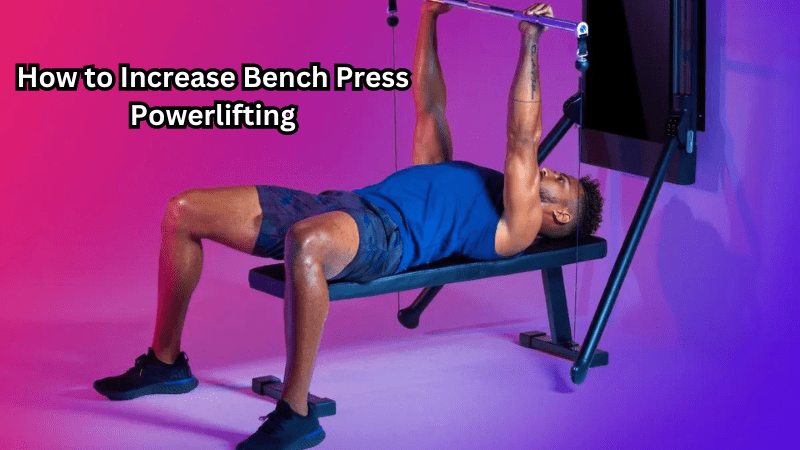
How to Increase Bench Press Powerlifting
Share
In the realm of powerlifting, the bench press stands as a cornerstone exercise crucial for building upper body strength and overall power.
Mastering the bench press not only enhances muscle mass and endurance but also significantly boosts performance in competitive settings. Increasing bench press strength is a common goal for powerlifters seeking to elevate their training and achieve new personal records.
This guide delves into proven techniques and strategies to maximize your bench press capabilities. From understanding proper form and advanced training methods to incorporating essential nutrition and recovery practices, you'll gain the tools needed to push your limits and realize your full potential on the bench.
Overview Powerlifting
Powerlifting is a strength sport that involves three main lifts: the bench press, squat, and deadlift. It focuses on measuring an athlete's maximal strength in each lift rather than their overall physical fitness or athleticism.
Powerlifting competitions are divided into weight classes and involve three attempts at each lift. The goal is to lift as much weight as possible for one repetition (1RM) in each lift, with the total of all three lifts combined being the final score.
Powerlifting requires a combination of explosive power and muscular endurance, making it a challenging and demanding sport. It is popular among both recreational lifters and competitive athletes due to its focus on pure strength and ability to push the limits of the human body.
Now, let's dive into the specific techniques and strategies to increase your bench press in powerlifting. So, it is essential to have a strong foundation in all three lifts for success in powerlifting competitions.
Understanding the Bench Press
The bench press is a compound exercise that primarily targets the chest, shoulders, and triceps muscles.
It involves lying on a flat bench with your feet planted on the ground, lifting a barbell off the rack, and lowering it to your chest before pressing it back up. The key to mastering the bench press is understanding proper form and technique.
Firstly, ensure that your feet are firmly planted on the ground with your hips, back, and head in contact with the bench at all times. Secondly, grip the bar slightly wider than shoulder-width apart, with an overhand or underhand grip, depending on personal preference. As you lower the bar to your chest, keep your elbows at a 45-degree angle and maintain a tight core.
Once the bar reaches your chest, explosively press it back up to the starting position. It's crucial to control the weight throughout the entire movement and avoid excessive bouncing or arching of the back. Proper form not only maximizes muscle engagement but also reduces the risk of injury.
How Does the Bench Press Work?
The bench press primarily targets the pectoralis major muscle, but it also engages other muscles, such as the deltoids, triceps, and upper back.
As you push the barbell up, your chest muscles contract to extend your arms and lift the weight. The triceps assist in elbow extension, while the shoulders stabilize and support the movement.
Additionally, the bench press also activates the core muscles to maintain stability and proper form. The legs and feet play a crucial role in providing a solid foundation and generating power from the ground up.
How to Increase Bench Press Powerlifting?
To increase your bench press powerlifting strength, it's essential to focus on both training and recovery. Here are some tips to help you maximize your bench press capabilities:
Training Techniques for Increasing Bench Press
Powerlifters use various training techniques to increase their bench press strength. Some popular methods include:
- Progressive Overload: Gradually increasing the weight lifted over time to continually challenge your muscles and promote growth.
- Repetition Range Training: Focusing on specific rep ranges (e.g., 3-5 reps) to target different muscle fibers and build overall strength.
- Incorporating Accessory Exercises: Including exercises that target specific muscle groups used in the bench press, such as tricep pushdowns or chest flies.
- Paused Reps: Adding a pause at the bottom of the bench press movement to increase time under tension and build strength.
Nutrition for Bench Press Powerlifting
Proper nutrition plays a crucial role in increasing bench press strength. A balanced diet consisting of lean protein, complex carbohydrates, healthy fats, and plenty of fruits and vegetables is essential for providing your body with the necessary fuel and nutrients for optimal performance. Additionally, consuming enough calories to support muscle growth is also necessary, as powerlifting requires a significant amount of energy.
Recovery from Bench Press Powerlifting
Rest and recovery are just as important as training when it comes to increasing your bench press strength. Adequate sleep and rest days allow your muscles to repair and grow after intense training sessions. Incorporating foam rolling, stretching, and massage can also help alleviate muscle soreness and prevent injury.
Programming and Periodization
Having a well-structured training program and periodization plan is crucial for long-term progress in bench press powerlifting. Periodization involves dividing your training into specific blocks or phases, such as hypertrophy (muscle growth), strength, and peak performance. Each phase has a specific focus to target different muscle qualities and prevent plateauing.
Mental Strategies
Bench press powerlifting also requires mental strength and determination. Some helpful mental strategies include visualizing success, setting achievable goals, and using positive self-talk to overcome challenges and push through tough training sessions.
These techniques, combined with proper form, training, nutrition, recovery, and programming, can help you increase your bench press strength for powerlifting. Remember to always prioritize safety and listen to your body during training to avoid injury.
Tips for Bench Press Powerlifting
- Ensure proper form and technique to maximize muscle engagement and prevent injury.
- Gradually increase weight or volume over time through progressive overload.
- Incorporate accessory exercises to target specific muscle groups used in the bench press.
- Use training techniques such as paused reps, repetition range training, and progressive overload to build strength.
- Maintain a balanced diet consisting of lean protein, complex carbohydrates, healthy fats, and plenty of fruits and vegetables to fuel your body for optimal performance.
- Prioritize rest and recovery, including enough sleep and incorporating foam rolling, stretching, and massage into your routine.
- Have a well-structured training program with periodization to target different muscle qualities and prevent plateauing.
- Use mental strategies such as visualization, goal setting, and positive self-talk to stay motivated and push through tough training sessions.
- Listen to your body and prioritize safety during training to avoid injury.
Consistency is key - stick to a structured program and be patient with progress. Results will come with dedication and hard work over time. These tips can help you increase your bench press strength for powerlifting and reach your goals.
Common Bench Press Myths
There are many myths and misconceptions surrounding the bench press in powerlifting. Here are some of the most common ones debunked:
- Myth: More weight equals more strength. While progressive overload is essential for building strength, it's not solely about lifting the heaviest weight possible. Proper form, muscle engagement, and targeted training techniques also play a significant role in increasing bench press strength.
- Myth: Only men can excel at bench press: This myth is completely false - women can excel at bench press just as much as men with proper training and dedication.
- Myth: Arching your back is cheating: A moderate arch in the back during bench press helps engage all the muscles in the upper body, leading to better performance and reduced risk of injury. Cheating is not considered cheating in powerlifting competitions.
- Myth: You have to bench press every week to see results. While consistency is essential for progress, it's also crucial to incorporate rest and recovery into your training plan. Overtraining can lead to plateaus or even injury.
By understanding these myths and focusing on proper training techniques and strategies, you can maximize your bench press strength for powerlifting success.
What Other Exercises Help Improve Bench Press?
Aside from the bench press itself, there are several other exercises that can help improve your bench press strength. These include:
- Overhead Press: This exercise targets the shoulders and triceps, which are also crucial for a strong bench press.
- Pull-Ups/Chin-Ups: These bodyweight exercises target the back muscles, which play a role in stabilizing and supporting the bench press movement.
- Dumbbell Chest Flyes: This exercise helps develop chest muscle fibers and supports proper form in the bench press.
Incorporating these exercises into your training routine can help target different muscle groups and improve overall strength for a stronger bench press.
FAQs
How can I improve my bench pressing technique to increase bench press strength?
Improving your bench pressing technique involves proper alignment and movement. Ensure your shoulder blades are retracted and pressed firmly against the bench to create a stable base. Also, focus on keeping your shoulder joint in a safe position by lowering the bar with control and driving through your feet during the lift.
What variations should I include in my bench press workout to overcome bench press struggles?
To overcome bench press struggles and increase bench press strength, incorporate variations like the incline bench press and pause bench press into your bench press sessions. The incline bench press targets the upper chest, while the pause bench press builds power by improving control at the bottom of the lift.
How does the incline bench press help increase bench press max?
The incline bench press helps increase bench press max by strengthening the upper chest, shoulders, and triceps, which are crucial for improving overall bench pressing power. Including an incline bench press in your bench press workout can lead to better overall development and higher performance on the flat bench.
What are some tips for maximizing bench press sessions in the weight room?
To maximize your bench press sessions in the weight room, focus on consistent bench press technique, incorporate variations like pause bench press, and prioritize recovery between sessions. Also, ensure that you are progressively increasing the weight while maintaining proper form to build strength and avoid injury.
Conclusion
Increasing your bench press strength is a journey that demands dedication, consistency, and the right strategy.
By understanding the fundamentals of proper form, incorporating progressive training techniques, and focusing on nutrition and recovery, you can make significant strides in your powerlifting performance. Remember, success in the bench press is not just about brute strength but also about technique and mental fortitude.
Embrace the process, stay committed to your goals, and don't be afraid to push past your limits. With these tools and insights, you're well-equipped to elevate your bench press capabilities and achieve new personal records. Keep striving, and the results will follow.

